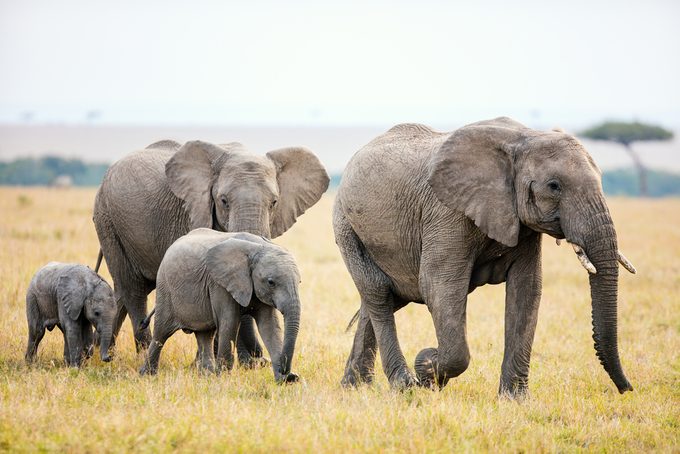This Is How Many Elephants Are Left in the World
Updated: Jul. 15, 2021
While the number of elephants is in steep decline, there are still reasons to be hopeful that we can save these beautiful animals.

One hundred years ago, there were about ten million African elephants and 100,000 Asian elephants (the two primary species), reports World Wildlife Magazine. Those numbers have plummeted in the last century, and the survival of these majestic creatures is in question. Right now there are approximately 400,000 elephants left in the world. Find out just how smart elephants really are.
African elephants are the globe’s largest land animals, weighing in at an average of six tons, a half-ton more than Asian elephants. African elephants roam the Congo Basin and the coastal regions of Eastern Africa. Asian elephants can be found mainly in the Eastern Himalayas, as well as the forest regions of Thailand, China, Cambodia, and Vietnam. Both species are threatened by poachers seeking to sell their ivory tusks, skin, and other body parts. They are also threatened by capture to fuel the tourism trade, as well as habitat loss due to deforestation.
Presently, African elephants are classified by the IUCN Red List as vulnerable to extinction, while Asian elephants are classified as endangered. In a bit of good news, conservation efforts are helping the African elephant population to rebound—their numbers are slowly increasing. Unfortunately, the population of Asian elephants is still in decline; one type of Asian elephant is on the list of 14 animal species that could disappear in your lifetime.
Elephants require a lot of land and resources to survive, and this often puts them at odds with local human populations. In Kenya alone, farmers and wildlife rangers kill between 50 and 120 elephants each year when the animals damage farms. The World Wildlife Fund is encouraging non-lethal methods to keep elephants from eating crops, such as “chili bombs”—a combination of chili and dung. In addition, the locals are learning methods of farming that help keep elephants at bay and planting new crops that require less land.
If you can’t make it out to the Congo or to India yourself, there are still ways you can view and help save these precious creatures. You can “adopt” an elephant and donate funds to local rangers. If the number of elephants was lower than you thought, find out 13 more animal species you never knew were endangered, including the cheetah.
